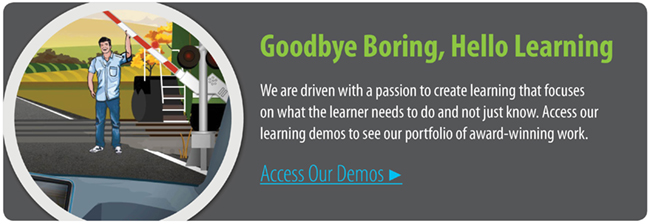Blog
5 e-Learning Media Design Tips Inspired by Ugly Sweaters
by Christopher Palm, media artist


e-Learning Interface Design Even a Four-Year Old Can Navigate
By Christopher Palm | December 12, 2013 | Custom Learning | 0 Comments
by Christopher Palm, media artist
 A few months ago at a family get-together I was amazed to watch as my four-year old niece got a hold of my Windows Phone, something she had never interacted with before. She jumped into the games I had downloaded and placed in the Kid’s Corner and within seconds she was playing. This got me thinking. At only four, she hasn’t learned how to read yet, but she was still able to get to the content she wanted without any help or guidance. Clearly kids these days are born with an innate ability to navigate digital devices! Or, are these interfaces built in such an intuitive way that navigating them is child’s play?
A few months ago at a family get-together I was amazed to watch as my four-year old niece got a hold of my Windows Phone, something she had never interacted with before. She jumped into the games I had downloaded and placed in the Kid’s Corner and within seconds she was playing. This got me thinking. At only four, she hasn’t learned how to read yet, but she was still able to get to the content she wanted without any help or guidance. Clearly kids these days are born with an innate ability to navigate digital devices! Or, are these interfaces built in such an intuitive way that navigating them is child’s play?
Since Apple hasn’t yet found a way to market iPhones to babies in the womb (I’m sure it’s just a matter of time), I’m going to go with a well-designed interface being the key component in this situation. I’m sure other factors, such as exposure to touchscreen devices, play a role but for now I’m just going to focus on the interface.

My niece Bella playing on her mom's Android
It's interesting to note that some of the screens my niece blew past did, in fact, contain instructions and/or text, which reminded me of the axiom “Nobody reads instructions” (though in her case she really can’t read.) Even button text was irrelevant to her, but she still knew that to go forward, she tapped the forward arrow on the right side of the screen instead of the one on the left.
 Screenshot from Turbo Racing League
Screenshot from Turbo Racing League
So what am I really getting at? Instructions are overrated! An intuitively built interface with strong visual cues will aid a learner far more than any instructional text ever could. Yet instructions seem to plague almost all e-learning. I understand why; we build our e-learning to be useable by a very wide-range of users, many of whom may not be computer savvy. I get this, but there are better ways of handling these situations rather than writing out each and every mouse click a learner must take to proceed.
Top 3 Tips for Writing Instructions:
- Let the interface do the talking: Use contrast, animation, shape/size and above all, consistency to alleviate the need for cumbersome text. Placement of interactive components on the screen is crucial! Use eye movement patterns as your call to action―the eye’s hotspot is generally the mid-left section of the page, so place your actionable or point-of-focus elements in that region.
- Be brief and blunt! Think of instructions in the form of a prompt instead of a 30-step DIY toilet repair manual. Let go of your inner ‘niceness’ and fight the urge to say “please” or “when you are ready.”
- Don’t point out the obvious. If all there is to do on a page is read some text and click “Continue”, do we really need instructions? Sounds silly, right? But I have seen this before and on more than one occasion!
Okay, so what other options do we have to work with?
A help section is a great way to aid a learner who is lost without cluttering your interface. By providing a few screens with callouts that indicate different button types and how to interact with them, you can provide support for the technically challenged learner while allowing those who are more savvy to move on at their own pace.
On more complex interactions, a briefly animated walkthrough is an option (make sure to include a “Skip” button though).
You can also hide your instructions within the content the learner is reading. For example, the question “Which of these statements is true?” already implies that the learner is going to need to interact with something.
I think as time moves on, we’ll start seeing fewer and fewer written instructions in e-learning as new learners tend to want to just dive into a situation and figure it out on the fly. The situation may vary depending on your major demographic, content, and learning objectives, but putting the learner into a challenge-based scenario―as opposed to holding their hand the entire way― is a very powerful learning approach.
.png?width=135&height=135&name=Chris(120).png)
About the Author: Christopher Palm
Comments
Would you like to leave a comment?
Related Blog Posts

By: Christopher Palm | Feb, 2014
Category: Custom Learning

Blog
3D e-Learning, Closer Than You May Think
by Christopher Palm, media artist
By: Christopher Palm | Aug, 2013
Category: Custom Learning

Blog
Creating the Perfect E-Learning Interface Design
by Christopher Palm, media artist
By: Christopher Palm | May, 2013
Category: Custom Learning


